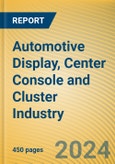1. Judging from the installation data, in 2024, more brands follow suit and adopt the cluster-free cockpit solution, the installation volume of rear entertainment screens doubled, and the installation volume of combined display (including dual-display and triple-display) continue to increase.
(1) Cluster-free is being deepened, and Chinese independent brands mostly use a combination of HUD and center console screen
The "cluster-free" craze led by Tesla continued to increase in 2024. In 2024, the sales of cluster-free models exceeded 1.5 million, a year-on-year increase of 50.0%. Among them, Li Auto's five models contributed a total of 32.4% of the market share. Deepal's three models contributed 7.9% of the market share.Different from Tesla's single center console screen solution, Chinese independent brands mostly use a combination of HUD and center console screen to replace the cluster. Representative brands include Li Auto and Deepal. Li Auto's full range of models use a solution of HUD + safe driving interactive screen + center console screen to replace the cluster; Deepal S07, Deepal S05, and Deepal L07 use an AR-HUD + center console screen solution to replace the cluster.
(2) The installations of rear entertainment screens have doubled, with second-row roof being the main installation location
According to the data in 2024, the sales volume of new cars equipped with rear entertainment screens was close to 900,000 units, a year-on-year increase of 121.8%. in terms of vehicle types installed, mid-to-large-sized sedans accounted for 48.1% of these sales, serving as the primary driving force, followed by midsize SUVs at 17.0% and MPVs at 13.1%.From the installation location point of view, the second-row entertainment screens are mainly installed on second-row roof and behind the front-row center armrest. in terms of screen control, the second-row entertainment screens have developed a variety of control methods such as touch, voice, gesture, remote control, functional control screen, etc.
(3) The installation volume of combined displays (including dual-display and triple-display) continues to rise, with dual-display solutions accounting for more than 90%
In 2024, a total of 3.378 million new cars equipped with combined display solutions were sold, of which nearly 250,000 were equipped with triple-display, a year-on-year increase of more than 200%. Specifically, the AITO M9 model alone contributed more than 60% of triple-display market share, while Voyah series accounted for nearly 20%.From the installation solution point of view, since the electronic exterior rearview mirror (CMS) was approved for road use, the first model adopting five-display solution, Lingxi L, was launched in September 2024. It adopts a five-display layout with three 12.3-inch displays + two 7-inch CMS displays.
2. For display technology, the number of OLED models is increasing, and curved screens and curved-edge screens are being used in cars
Automotive display panels are gradually transitioning from LCD to OLED. in the field of OLED, curved OLED and curved-edge OLED have been installed in cars. Foldable OLED and rollable OLED have mature technical solutions.In October 2024, Voyah Courage was launched. This model uses the industry's first curved-edge OLED display screen. Its’ left can adjust the brightness, and the right supports volume adjustment. It is reported that this product comes from BOE Varitronix. Moreover, its center console screen supports left and right sliding.
In March 2025, Yangwang U7 was launched. This model uses a display combination of 23.6-inch LCD cluster + 12.8-inch OLED curved center console screen + 23.6-inch OLED co-pilot screen. This curved OLED center console screen was first used on Yangwang U8 in 2023, with a curvature of R800.
From the supplier's perspective, there are mature technical solutions for foldable OLED and rollable OLED. Foldable and rollable displays were first used in the mobile phone field and quickly became popular. In recent years, many display suppliers have also launched their own rollable /foldable display products. Those displays benefit from the variability of their display form. They can be adjusted in the cockpit according to driving conditions and usage purposes, and can significantly improve interior design of the vehicle by minimizing the volume and installation space.
BOE's 15.05-inch electric foldable screen
- Developed based on BOE's f-OLED technology, this product has a bending radius of R3 and can be flexibly unfolded and hidden according to different usage scenarios.
- LG Display’s foldable OLED display.
- It can be installed behind the front seat and used as a display, or it can be taken down and used as a portable tablet for work, thus creating a "mobile office" scenario.
- The 17-inch foldable OLED product can not only watch large-size video images, but also adjust the folding angle of the screen to allow the product to be used as a 12.3-inch tablet computer.
Table of Contents
Companies Mentioned
- Continental
- Denso
- Visteon
- Bosch
- FORVIA
- Marelli
- Desay SV
- ADAYO
- Hangsheng Electronics
- Huawei
- Tianyouwei Electronics
- Mobis
- Yuanfeng Technology
- Appotronics
- Harman
- JDI
- LG Display
- Tianma Microelectronics
- BOE
- TCL CSOT
- AU Optronics
- innolux Corporation
- Visionox
- HIWAY Technology
- HKC
- Huaqin Technology
- Beidou intelligent Connected Vehicle Technology Co., Ltd. (BICV)








